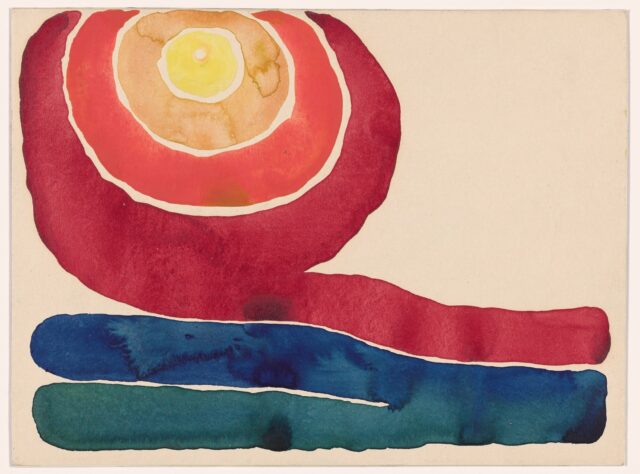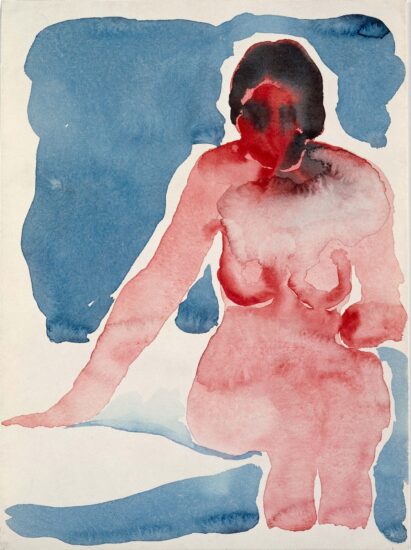
Georgia O’Keeffe, Evening Star No.III, watercolor on paper mounted on board, 1917 (Museum of Modern Art, New York. Mr. and Mrs. Donald B. Straus Fund, 1958. © 2022 Georgia O’Keeffe Museum / Artists Rights Society, New York)
GEORGIA O’KEEFFE: TO SEE TAKES TIME
MoMA, Museum of Modern Art
11 West 53rd St. between Fifth & Sixth Aves.
Through August 12, $14-$25 (sixteen and under free)
212-708-9400
www.moma.org
In the catalog for the 1950 exhibition “An American Place,” Georgia O’Keeffe wrote, “A flower is relatively small. Everyone has many associations with a flower — the idea of flowers. You put out your hand to touch the flower — lean forward to smell it — maybe touch it with your lips almost without thinking — or give it to someone to please them. Still — in a way — nobody sees a flower — really — it is so small — we haven’t time — and to see takes time, like to have a friend takes time. If I could paint the flower exactly as I see it no one would see what I see because I would paint it small like the flower is small.”
Appropriately born in a town called Sun Prairie in Wisconsin in 1887, O’Keeffe is beloved for her colorful paintings of flowers, animal skulls, and the desert. In the exhibition “To See Takes Time,” MoMA offers a rare look at her series of works in charcoal, pencil, watercolor, and pastel, with 90 of the more than 120 drawings and paintings dating from 1915 to 1926, before she moved to Santa Fe, where she died in 1986 at the age of 98. Organized by Samantha Friedman with Laura Neufeld and Emily Olek, the show introduces viewers to other, unexpected sides of O’Keeffe, steeped in abstraction.
The works range from the swirling, colorful 1915 pastel Special No. 33 and a trio of 1916 line drawings done in charcoal, watercolor, and watercolor and pencil, respectively, to fourteen 1959-60 pieces depicting similar shapes in nature, culminating in the 1964 oil painting On the River, the latest work in the show.

Georgia O’Keeffe, Seated Nude XI, watercolor on paper, 1917 (Metropolitan Museum of Art, New York. Purchase, Mr. and Mrs. Milton Petrie Gift, 1981. © 2023 Georgia O’Keeffe Museum / Artists Rights Society, New York)
The show features such other highlights as four 1916 works on paper of the inside of a tent, made when O’Keeffe was studying at the University of Virginia; 1916-17 pencil drawings of Palo Duro Canyon; all eight 1917 Evening Star watercolors; eight early nudes; charcoal drawings of New York City from 1926 and 1932; a quartet of portraits of artist Beauford Delaney from 1943; and a pair of exquisite pencil on paper drawings of a patio door that recalls the work of Danish painter Vilhelm Hammershøi.
And no need to worry; purists will also find a handful of banana flowers and canna lilies as well as an orchid and a few vaginal works.
In the 1950 catalog, O’Keeffe continued, “So I said to myself — I’ll paint what I see — what the flower is to me but I’ll paint it big and they will be surprised into taking time to look at it — I will make even busy New-Yorkers take time to see what I see of flowers.”
So, tourists and busy New-Yorkers, take your time once you get to MoMA, but get there soon, because the exhibition closes August 12.
[Mark Rifkin is a Brooklyn-born, Manhattan-based writer and editor; you can follow him on Substack here.]